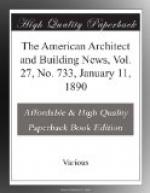Some little time since a gentleman from a neighboring city called upon me for information upon the subject of coverings in general and their comparative values. Being an intelligent man he said frankly at the outset that he knew very little on the subject. He had, however, in common with all of us, heard the word “asbestos” used as a shibboleth for years, but he desired definite knowledge, and after he had digested the information he should act on his judgment. I devoted sufficient time to him to put him in possession of the salient points of the subject. His understanding was acute. He left me to seek elsewhere further light upon this matter. After some few days he returned and directed that the magnesia covering be applied to his work. In the course of conversation he remarked that he had received great diversity of advice from those to whom he had gone. One man, who had been years in the business of selling steam plants, told him that the best thing for him to use was hair-felt, even though the steam-pressure might run up to 125 pounds to the inch. Now, as a matter-of-fact, the man who gave that advice simply showed himself an unsafe guide; and from his inability to keep abreast with modern knowledge, that he had no conception of the fire-hazard which his advice was to thrust upon the innocent inquirer, and that his advice was little short of being morally criminal.
The subject of the fire-hazard of organic coverings has been pretty thoroughly investigated and can be pretty well-known, when there is any inclination to get out of ruts which long years of travelling in has deepened. How many fires (cause unknown?) have really originated from the slow carbonizing of organic material on steam-pipes? It is but recently that the hair-felt covering on the steam end of a Worthington pumping-engine, within ten miles of us, not only burnt itself but destroyed some thousands of dollars worth of walnut lagging. Cases of the combustion of these organic coverings are numerous and are well-known.
Few appreciate the great loss of heat from uncovered or imperfectly covered pipes. Many have an indistinct impression that there may possibly be some slight loss. But there is in many cases an absence of knowledge upon this subject where it should be complete. The most correct data available show that the radiation from uncovered two-inch steam-pipe, with 60 pounds steam-pressure, is 391.83 kilo. centigrade heat-units one foot one hour, or 21,739.78 kilos. of coal for 100 feet per year of 300 days of 10 hours each; one kilo. equals 2,205 pounds. Properly combining these figures we see that there are 23.97 tons of coal lost by radiation from that uncovered pipe. If the coal costs $4 per ton, the radiation from this 100 feet of pipe will amount to $95.87. From the same pipe covered with Wm. Berkefield’s fossil meal composition, 32/100-inch thick, the most powerful inorganic non-heat conductor used as a covering at the time these investigations were made, there was




